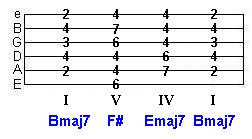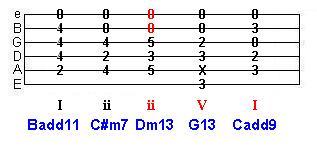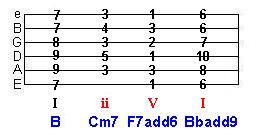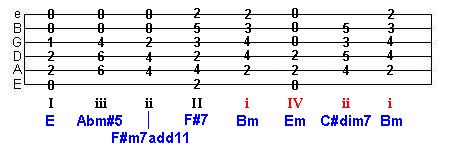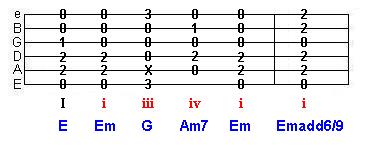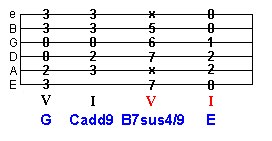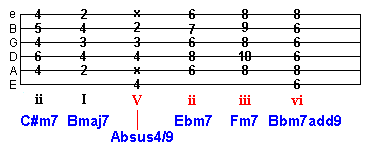Chord Progressions - Part 4
In chord
progressions part
3,
we looked at creating minor key chord progressions, altering chords in
the scale and using "gateway chords" to make our melodies more
interesting. Free chord
cheat sheet Free chord
cheat sheetLearn how guitar chords work together in any key... Click here to start now |
In this final part, we'll look at the dreaded changing key. When you change key, you effectively change the tonic chord. So, if you started a progression in E major, and changed key to F# major, the chord scale would be adjusted accordingly so F# major becomes the tonic (I) chord.
It's not that simple though! You could just change key to anything from any chord, but most of the time it will sound so dis-jointed, so out of place that you could ruin the "journey" of the progression. Changing key, in most cases, has to be smooth, logical and bring your song to the next level. This lesson will show you how to accomplish this, with examples.Changing key in your chord progressions
First and foremost, bear in mind that a lot of the most widely loved songs don't change key at all! A lot of them just keep it simple and stick to the chord scales we've been looking at. So don't get the idea all the songs you write need to change key a hundred times to be "epic".
Only change key when you want a change of direction in your song. Key changes compliment the following quite well...
-
Change in tempo or rhythm
-
When you switch a guitar effect on or "up" the tone of your guitar
-
When the vocalist wants to go for that climax (I mean like a crescendo or something...)
-
When you've been playing the same progression for a while through a song and want it to sound fresh again.
The scale/chord merging technique
The easiest way to plan a key change is to first look at the notes of the chord you're playing just before you change key. So, if we started off in the B major chord scale...

We can also start on this chord (although progressions don't always have to start on the tonic chord as we saw in part 3) and use the chord scale to build a simple B major key progression...
(Click the tabs in this lesson to hear)
Sounds nice and simple at the moment. So, to inject a bit of journey into it, we can change key before we return back to that Bmaj7 tonic.
As I said before, the notes in the chord just before you change key and move out of the chord scale are important here. So if we look at Emaj7 above, and where our index finger will be barred, we could keep our index finger there and try moving to Ab major (which is outside the B major chord scale) and make that the tonic for the new key. Ab major can be barred from the E string using the index finger in that same position as Emaj7 was in the tab above.
It's not so much that the fingerings are similar, that's just convenient - what matters is that you are "borrowing" notes in Ab major from that previous Emaj7 chord so it smooths the key change out.
Once we've found our "key change chord", we can build a progression using that new chord as the tonic. So in this case, Ab major becomes chord I, take a look and listen below...
Now, the red notes in the tab on the first Ab chord indicate the notes that were also used in the chord before - it's these notes that make the key change merge smoothly. Once you have this nailed, then you can hunt around for different voicings and inversions of that new chord (To learn about how to do this, see the guitar chord theory section).
|
Incidentally, by using the chord "merging" method above, you are in fact borrowing notes from the scale of the original tonic chord. So, in the example above, we started with Bmaj7 as the tonic, with B Ionian/major as its relative note scale. This scale can be played through any chords within that chord scale, but when we change key, the scale does too. The "merging" notes above are essentially notes from that initial B Ionian/major scale! The non-merging notes are from the new scale which starts when we change key. |
Here's another quick example of a key change using the note merging method (again, the merging notes are highlighted in red)...
So, we started on the tonic of B, and merged nicely into a new tonic of C.
The ii V I turnaround key change method
This is a technique used a lot in jazz to change key and is quite simple.
Basically, from the tonic chord, you change straight to the ii chord of the new key. This naturally then leads on to the tension chord of V before the return to the new tonic.
The great thing about this method is you can pretty much jump to any ii chord as long as you use 7th chords (using this method to change key from a triad to another triad is often too abrupt - using 7ths "softens" it up). Below is an example, starting on B again...
...and once you get to the new tonic you can continue the progression from that new key.
Parallel key changes
Another way to change key and mood is to switch a chord in the progression from its natural major or minor voicing to the other. The change can be with the tonic chord or any other chord in the scale.
First, minor to major as chord gateway into a new minor tonic. So if we start in E major and start a progression in that chord scale we can experiment with the switch...
In the above example, the ii chord in the scale became major and acted as a V chord gateway into a new minor tonic. You may find that you have to "reinforce" the new tonic by playing in that new chord scale for a couple of chords because the listener's ears will still be adjusting to the key change!
Another example could be using a parallel key change where the tonic chord changes from major to minor or vice versa. So you could start the progression, or even the whole song, on the major tonic and switch it to minor. This can be effective for catching listeners off guard...
I really like using that one - you get this sense of comfort starting on that major chord and then it all dissolves into minor misery! (forgive me for being overly dramatic).
Just don't over use parallel key changes in your songs. Keep them special. Another great thing about the major/minor switch is you can switch it right back to change the mood again.
The V gateway
Following these past 4 lessons, you should be aware of the most dominant tension chords within a chord scale.
We learned that the V chord in a progression is a key tension chords for returning back to the tonic (I).
Let's take a closer look at that V chord - we can use it to change key by moving to the V chord of the new tonic.
Take a look at the examples below and listen to how the switch to the V chord positions us ready for the new key...
Using the sus4 version of the V chord (in the case above, the V chord is B, so it's Bsus4) this adds to the tension before the new tonic. The added 9th adds yet another layer of tension to the important V chord.
Let's look at it used in a similar way in a (very crude) take on Jamiroquai's Space Cowboy...
So this time we've used a different key change interval to get to the V of the new key, but the effect is similar.
The important thing is, it doesn't sound too abrupt, like it's come from nowhere. It's a smooth transition, highlighting the natural tensions of the chord scale!
Try your own "V chord gateways". Start your chord progression in one key and, where appropriate, position your new V chord where you think it sounds good - you're now ready to re-affirm the new key from that V chord.That concludes the guitar chord progressions series
If you've been following this properly since the 1st part, we've come along way and you should now be equipped to create that perfect song. String 'em all together - chord scales, gateway chords, key changes, major key, minor key etc. and you should be able to get very progressive with your music (if you're a prog-rock fan, then all the more to inspire you).
Also, don't forget that great songs can be discovered by just randomly punching out chords, placing your fingers in unusual positions - don't completely restrict yourself to scales all the time. If you like what you hear, play it for god sake!
Thanks for sticking with it, I hope the rewards are very clear to you now! If you need a more comprehensive guide to songwriting on guitar, visit the chord progressions section here. It's the perfect follow on from these lessons.
| |
Tweet |
 Like This?
Subscribe & Learn More... Like This?
Subscribe & Learn More...Subscribe to the fretjam newsletter below for updates and extras, plus grab your free copy of Uncommon Chords: 101 Vibrant Voicings You Won't Find on a Typical Chord Chart. |





